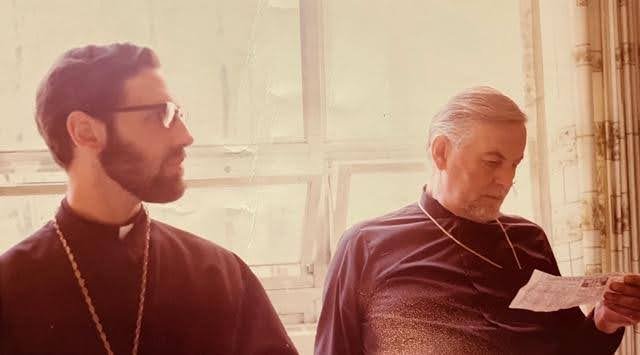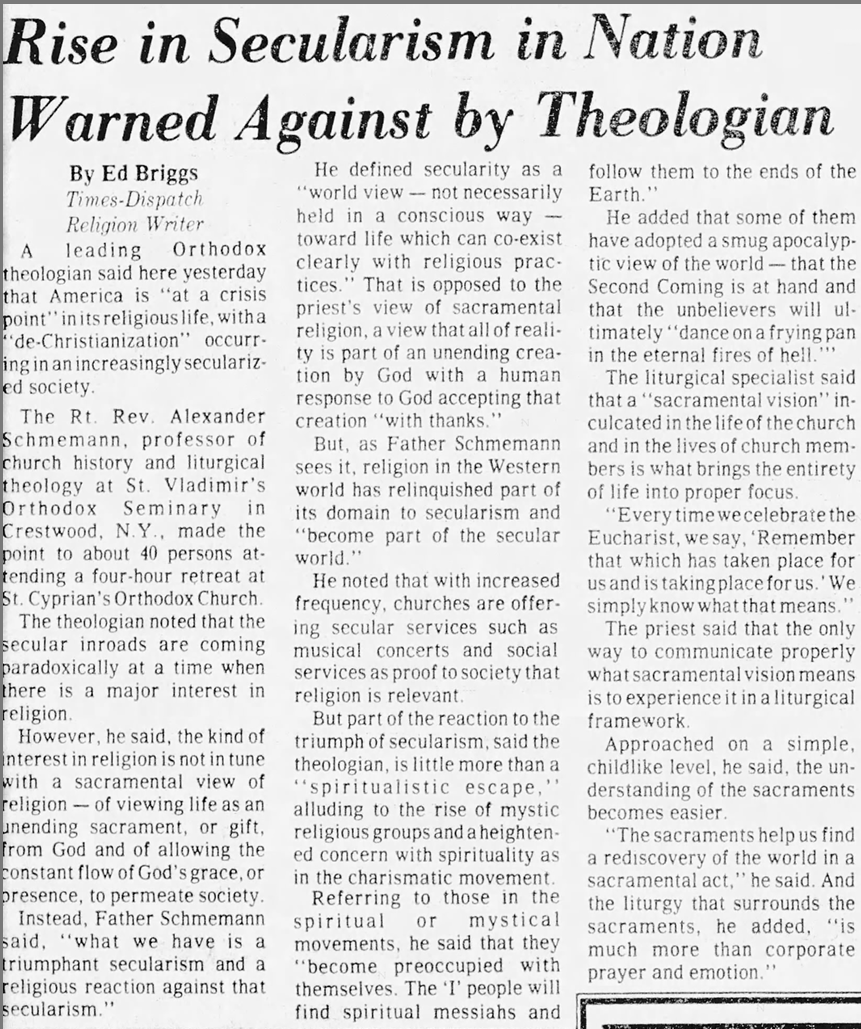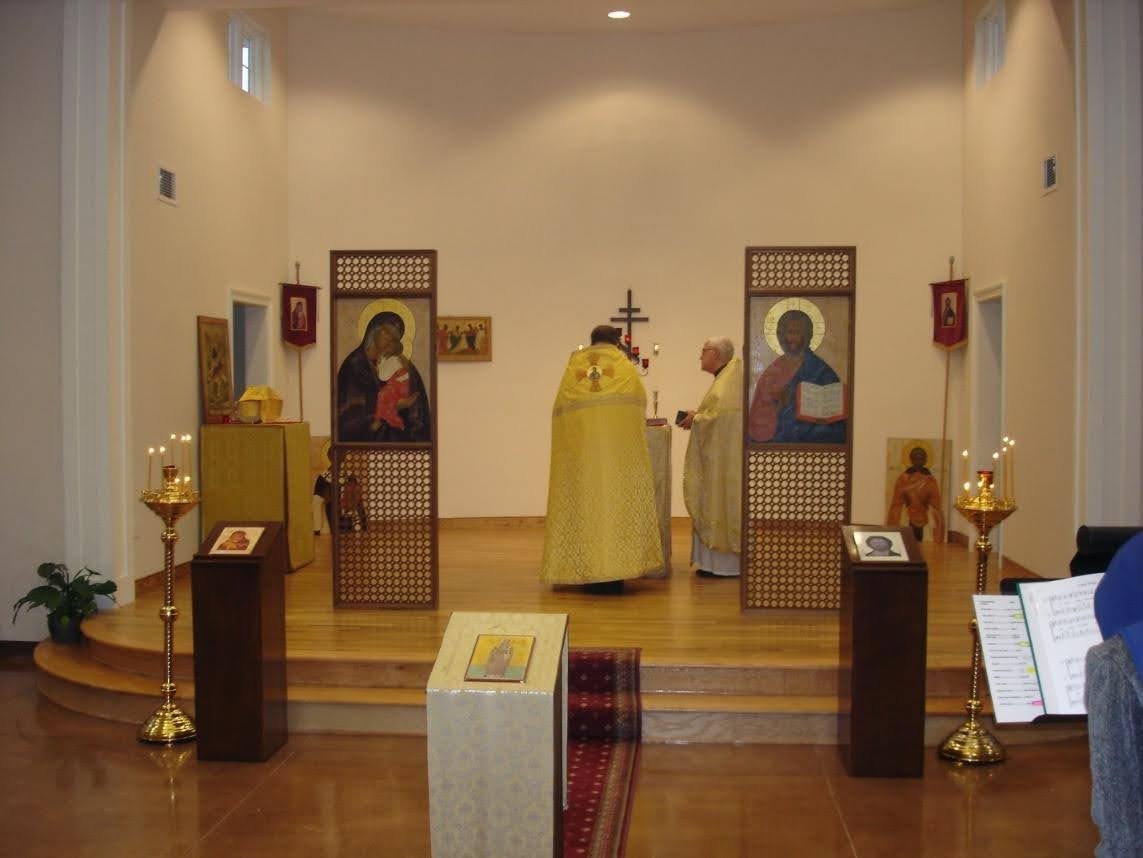50th Anniversary Timeline
Commit to the Lord whatever you do, and he will establish your plans.
Proverbs 16:3
1970 – The Orthodox Church in America is recognized as an ecclesiastically independent, or autocephalous, church of the Eastern Orthodox communion by its mother church in Russia.
1974 – Father George DeTrana, founding priest of St. Cyprian, is ordained.
Fr. George giving communion
What follows is the retelling of the first part of the history of our church in the words of Mary Ann DeTrana, the wife of Father George.
Fr. George’s Vision
We wanted to begin an Orthodox Church without being Russian or one of the other ethnic groups usually associated with the Orthodox Church. We just wanted to reflect the actual ethnic identity of the South.
Why the name St. Cyprian of Carthage?
The name St. Cyprian of Carthage was chosen with great forethought, and for specific reasons.
Firstly, we took a lot of effort to design the approach of the church in a way that it would be an Orthodox approach, not a Russian, Greek, or Antiochian one. So we had to pick a name that would not be recognized as Russian or Greek or Arab. It needed to be a saint that was not from any part of Europe or from the Middle East. So we went to Africa. Cyprian was a bishop of the African church in the second century. Nobody knows if he was black or white. It is very likely that he was black, and that was attractive because when we came to Richmond we hoped that we would have a mission to African-Americans. But the fact is he clearly wasn’t a Russian, he wasn’t a Greek, and he wasn’t an Arab.
The second reason we chose this name was that he was a bishop in the undivided Church. He was from the second century, before the Great Schism. Having come from a Catholic background and having had Protestant grandparents, we felt very strongly that we had to play the drum that the Orthodox Church was the universal Church to which everyone was welcome. So we intentionally had no flavor of the European or Russian Church, nor did we at any time wish to introduce that.
The third reason was a very specific reason. My husband wanted a saint who had left some writings. St. Cyprian has a vast amount of literature that he wrote himself. Fr. George found these writings to be important. From time to time over the years, he would bring the writings of St. Cyprian into his sermons. These were also some of the more popular books we had for curious people to borrow. We had to buy several copies.
Time at Grace and Holy Trinity
1976 – Holy Saturday Chrismation Service
Richmond Times Dispatch – October 9, 1976
Father George walked around Monroe Park, near VCU, and asked each church if they had any available space. At Grace and Holy Trinity Episcopal Church, he was told that they had no available space, but was given the suggestion of a nearby chapel, which was owned by VCU. Services were limited to Tuesday evening. Attendance was limited to my husband and me and our two children. Because we offered free refreshments, we soon attracted a few of the homeless that frequented Monroe Park.
After a few months, Grace and Holy Trinity contacted us and told us that they had some basement space available. Thus, we met in the basement of Grace and Holy Trinity Church Episcopal Church, 8 N. Laurel Street, Richmond, which is on the West side of Monroe Park. The basement had a very low ceiling and a pool table, which attracted the kids prior to and after services. To our kids, the basement of Grace and Holy Trinity has always been known as the “pool table church.” We slowly began to attract more people. My sister Jane McAllister was our first convert. A number of Fr. George’s students visited.
Property is purchased on Chamberlayne Avenue as the first dedicated location of St. Cyprian in 1977 - prior to the establishment of the O.C.A. Diocese of the South in 1978.
The idea of beginning a mission in the old Confederate capital of the South became more and more appealing. Moreover, we were drawn to the city’s racially integrated North Side. We were not interested in beginning another white suburban church. Although we didn’t make much progress towards developing a racially integrated church, in the beginning we managed to attract several African-American families.
I miraculously found a home that had been occupied by an elderly couple that was interested in financing the sale as a means of obtaining a continuing income. The home was a two-story brick structure with a slate roof, dating from the 1920s, that had fallen into almost complete disrepair. It was located on Chamberlayne Avenue, a wide, tree-lined, four-lane thoroughfare that served as the old U.S. Route 1 through Richmond. Prior to the opening of Interstate 95, U.S. Route 1 was the main highway along the East Coast, stretching from Maine to the Florida Keys. Thus, in 1977, we purchased the Chamberlayne property for forty-five thousand dollars and agreed to a fifteen-year mortgage.
We intentionally tried to pattern the interior of St. Cyprian’s after the Wren Chapel in Williamsburg. From the beginning, both of us believed very strongly that this was to be the Orthodox Church in America, bare floors, oriental rugs, brass candle stands, dark wood furniture, just like Colonial Williamsburg. I think it was his dream to one day build a church that would be like one of those Anglican jewels out in the country.
Richmond Times-Dispatch (Richmond, Virginia) – 29 Apr 1978
Richmond Times Dispatch – June 02, 1979
Clergy Visits to St. Cyprian
Visiting clergy always loved coming because of the congregational singing and emphasis on liturgy and joint prayer. One example is when Metropolitan Philaret of Minsk was visiting Richmond on a trip sponsored by the Presbyterian Church. Fr. George organized a Vespers for him with very little forewarning. I remember him saying, through a translator, that to be in this little church and hear the exact same music as he heard in Russia was a miracle. I also remember one of the non-Orthodox visitors asking him if he thought the Orthodox Church was the one true Faith. Everyone kind of held their breath. He paused, then said, “There are many paths to God; your job is to find one.” I always have been impressed with the wisdom of the Metropolitan’s response.
Visit from Fr. Alexander Schmemann – 1976
Richmond Times Dispatch – October 22, 1978
Bishop Dmitri – 1980
Richmond Times Dispatch – October 14, 1978
Richmond Times Dispatch – October 16, 1976
Richmond Times Dispatch – October 24, 1981
Fr. Paul Lazor visits St. Cyprian to give a talk on prayer.
1993 – Archbishop Dmitri Visit
1999 – Bishop Dmitri and Fr. George
Richmond Times Dispatch – November 07, 1981
Daily Press – Newport News – August 10, 1984 Southern Diocesan Assembly in Williamsburg
Richmond Times-Dispatch (Richmond, Virginia) – 17 Aug 1985
St. Vladimir Seminary Octet 1983 and again in 1985
1983 – Bishop Dmitri Visit
Formation of St. Ambrose Mission in Roanoke, Virginia
Roanoke Times – January 23, 1982
Fr. George spent years, maybe fifteen to twenty, trying to start St. Ambrose mission in Roanoke, Virginia. For years, Fr. George would hold a Vespers service every Friday evening. He would pack an extra meal, teach at J. Sergeant Reynolds, and then drive three and a half hours to Roanoke. He would hold Vespers and then return to Richmond. The services were held at St. Philip’s Lutheran Church on Peters Creek Parkway. Jim and Patty Nimitz attended, as well as a few others. The biggest supporter was Dr. Peter Van Densest. We also had a few students from Virginia Tech and Radford. Sometimes, Fr. George held Saturday Liturgies and would make it back for Saturday Vespers in Richmond.
Once again, the chosen name, St. Ambrose of Milan, was not Greek and not Russian. The name demonstrated the Orthodox connection with the Western church. That was very intentional.
A New Chapter
July 2004 – Fr. David Arnold assumes duties as “Priest in Charge” at St. Cyprian Mission
2004 – Weddings and baptisms continue.
2005 – Archbishop Dmitri blesses land purchased in Powhatan for the new temple.
The Congregation begins to grow...
2006 – Pentecost Vespers
September 2007: Blessing of the Foundation. Construction begins.
Fall 2008 – The temple is completed
Nativity Service in New Temple – 2008
Richmond Times-Dispatch (Richmond, Virginia) – 29 Nov 2008
St. Cyprian Continues to Grow
2010 – Pascha Baskets to be Blessed
2023 – Pascha Baskets to be Blessed
2016 – First Nativity Pageant at St. Cyprian
Pascha 2024 – St. Cyprian grows to 150 members.
Next Chapter
Process continues for construction of a new fellowship hall.















































